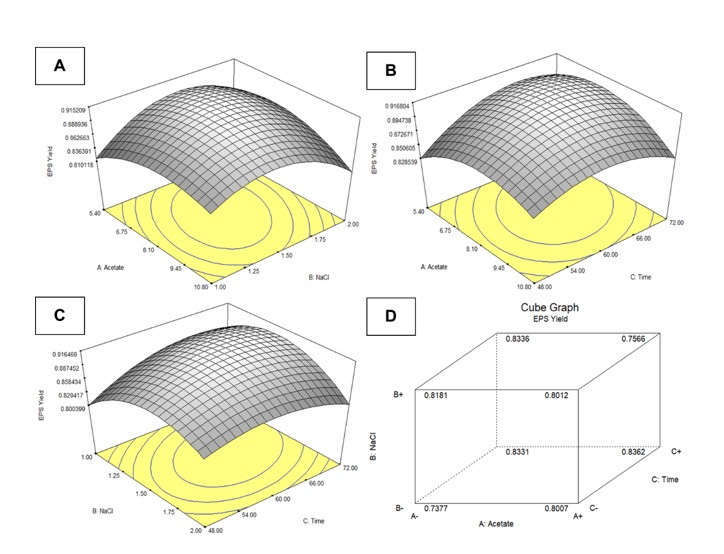Production and antioxidant activities of Exopolymeric substances from phototrophic purple non-sulfur bacteria Rhodopseudomonas palustris PP803
Keywords:
Antioxidant activities, Exopolymeric substances, Purple non-sulfur photosynthetic bacteriaAbstract
Purple non-sulfur photosynthetic bacteria (PNSB) is an interesting microbial group to produce exopolymeric substances (EPS). PNSB is highly productive and used a variety of carbon sources. However, the optimum culture conditions for EPS production are still less studied. In addition, the EPS has been used more in medical applications. Thus, this research aims to study the optimum conditions for EPS production from Rhodopseudomonas palustris PP803 and the EPS potential to reduce the effects of free radical activity. According to Central Composite Design (CCD) were revealed 7.82 g/L of acetate, 1.49 g/L of NaCl, and 62.83 hours of culture time result to gain the highest EPS yield (0.93) and show the highest concentration of NaCl influence from the EPS production of PP803.The antioxidant test showed that EPS at a concentration of 4 mg/mL had a Fe2+ chelating activity of 73.10% in vitro, which may be due to a group of functions. The carboxyl group in EPS structure may result in high metal chelating activity indicated that it is a good antioxidant potential. Therefore, it is a way to develop health products that have the ability to against free radicals in the future.
References
Neha K, Haider MR, Pathak A, Yar MS. Medicinal prospects of antioxidants: A review. Eur J Med Chem, 2019;178: 687-704.
Wang J, Hu S, Nie S, Yu Q, Xie M. Reviews on mechanisms of in vitro antioxidant activity of polysaccharides. Oxid Med Cell Longev, 2016.
Raza W, Makeen K, Wang Y, Xu Y, Qirong S. Optimization, purification, characterization and antioxidant activity of an extracellular polysaccharide produced by Paenibacillus polymyxa SQR-21. Bioresource technol, 2011;102(10): 6095-6103.
Abdelhamid S.A, Mohamed S.S, Selim M.S. Medical application of exopolymers produced by marine bacteria. Bull Natl Res Cent, 2020;44(1): 1-14.
Imhoff JF, Trüper HG. Anoxygenic phototrophic purple bacteria. In: Brenner DJ, Krieg NR, Staley JT, Garrity GM. editors. Bergey’ s manual of systematic bacteriology, The Proteobacteria, part a introductory essay. Springer-US; 2005, p. 119-132.
Chandy T, Rao GH, Wilson RF, Das GS. Development of poly (Lactic acid)/chitosan co-matrix microspheres: controlled release of taxol-heparin for preventing restenosis. Drug Deliv, 2001;8(2): 77-86.
Sasaki K, Watanabe M, Suda Y, Ishizuka A, Noparatnaraporn N. Applications of photosynthetic bacteria for medical fields. J Biosci Bioeng, 2005;100(5): 481-488.
Nunkaew T, Kantachote D, Nitoda T, Kanzaki H. Selection of salt tolerant purple non sulfur bacteria producing 5-aminolevulinic acid (ALA) and reducing methane emissions from microbial rice straw degradation. Appl Soil Ecol, 2015;86: 113-120.
Nunkaew T, Kantachote D, Nitoda T, Kanzaki H, Ritchie RJ. Characterization of exopolymeric substances from selected Rhodopseudomonas palustris strains and their ability to adsorb sodium ions. Carbohyd Polym, 2015;115: 334-341.
Liu J, Luo J, Ye H, Sun Y, Lu Z, Zeng X. Production, characterization and antioxidant activities in vitro of exopolysaccharides from endophytic bacterium Paenibacillus polymyxa EJS-3. Carbohyd Polym, 2009;78(2): 275-281.
Sheng GP, Yu HQ, Yue Z. Factors influencing the production of extracellular polymeric substances by Rhodopseudomonas acidophila. Int Biodeter Biodegr, 2006;58(2): 89-93.
Liu J, Luo J, Ye H, Sun Y, Lu Z, Zeng X. In vitro and in vivo antioxidant activity of exopolysaccharides from endophytic bacterium Paenibacillus polymyxa EJS -3. Carbohyd Polym, 2010;82(4): 1278-1283.
Sánchez-Moreno C. Methods used to evaluate the free radical scavenging activity in foods and biological systems. Food Sci Technol Int, 2002;8(3): 121-137.
Kantha T, Kantachote D, Klongdee N. Potential of biofertilizers from selected Rhodopseudomonas palustris strains to assist rice (Oryza sativa L. subsp. indica) growth under salt stress and to reduce greenhouse gas emissions. Ann Microbiol, 2015;65: 2109–2118.
Dungani R, Karina M, Subyakto AS, Hermawan D, Hadiyane A. Agricultural waste fibers towards sustainability and advanced utilization: A review. Asian J Plant Sci, 2016;15(1-2): 42-55.
Nookongbut P, Kantachote D, Megharaj M. Arsenic contamination in areas surrounding mines and selection of potential As-resistant purple non sulfur bacteria for use in bioremediation based on their detoxification mechanisms. Ann Microbiol,2016;66(4): 1419–1429.
Seesuriyachan, P., Kuntiya, A., Hanmoungjai, P., Techapun, C., Chaiyaso, T., Leksawasdi, N. Optimization of exopolysaccharide overproduction by Lactobacillus confusus in solid state fermentation under high salinity stress. Biosci Biotech Bioch, 2012;110905: 1-6.
Prasertsan P, Wichienchot S, Doelle H, Kennedy JF. Optimization for biopolymer production by Enterobacter cloacae WD7. Carbohyd Polym, 2008;71(3): 468-475.
Yuan YV, Bone DE, Carrington MF. Antioxidant activity of dulse (Palmaria palmata) extract evaluated in vitro. Food Chem, 2005;91: 485–494.
Liu J, Luo J, Ye H, Sun Y, Lu Z, Zeng X. Medium optimization and structural characterization of exopolysaccharides from endophytic bacterium Paenibacillus polymyxa EJS-3. Carbohyd Polym, 2010;79(1): 206-213.
Abuja, P.M., Albertini, R. (2001). Methods for monitoring oxidative stress, lipid peroxidation and oxidation resistance of lipoproteins. Clinica Chimica Acta, 306, 1–17.

Downloads
Published
How to Cite
Issue
Section
License
Copyright (c) 2020 Naresuan Phayao Journal

This work is licensed under a Creative Commons Attribution-NonCommercial-NoDerivatives 4.0 International License.
ผู้นิพนธ์ต้องรับผิดชอบข้อความในบทนิพนธ์ของตน มหาวิทยาลัยพะเยาไม่จำเป็นต้องเห็นด้วยกับบทความที่ตีพิมพ์เสมอไป ผู้สนใจสามารถคัดลอก และนำไปใช้ได้ แต่จะต้องขออนุมัติเจ้าของ และได้รับการอนุมัติเป็นลายลักษณ์อักษรก่อน พร้อมกับมีการอ้างอิงและกล่าวคำขอบคุณให้ถูกต้องด้วย
The authors are themselves responsible for their contents. Signed articles may not always reflect the opinion of University of Phayao. The articles can be reproduced and reprinted, provided that permission is given by the authors and acknowledgement must be given.







